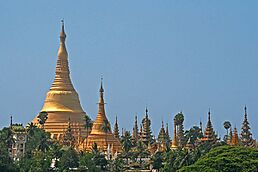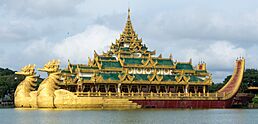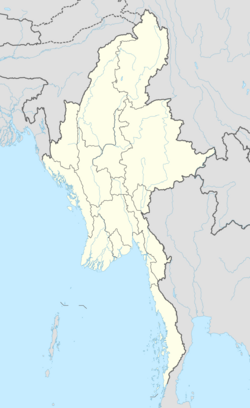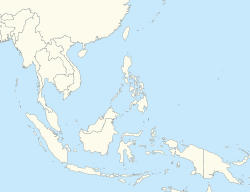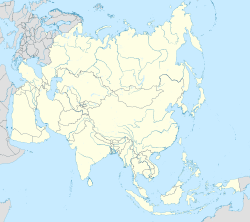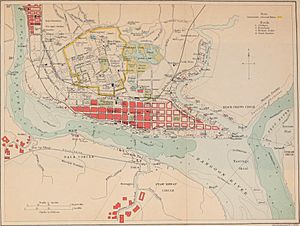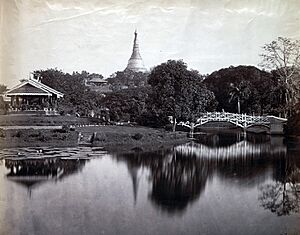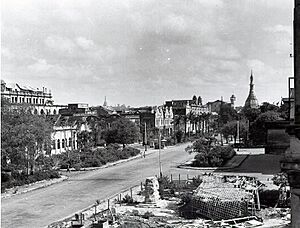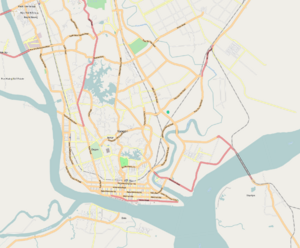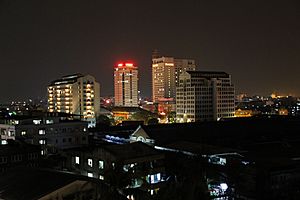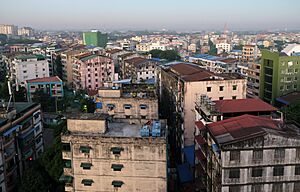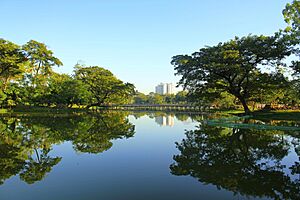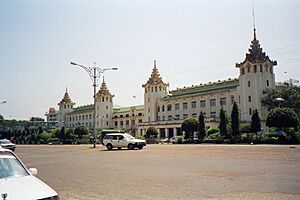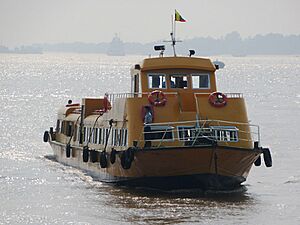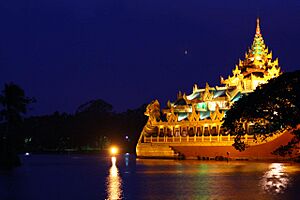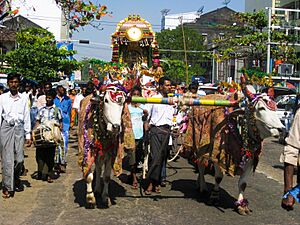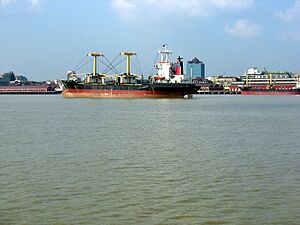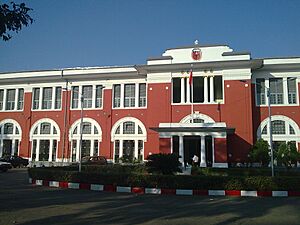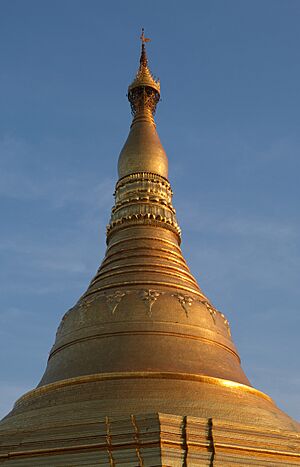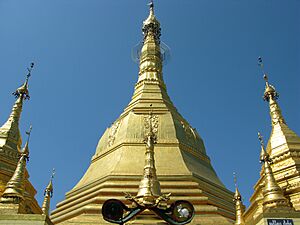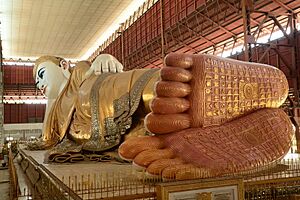Yangon facts for kids
Quick facts for kids
Yangon
Rangoon
|
||
|---|---|---|
|
City
|
||
| Yangon City | ||
|
Clockwise from top: Shwedagon Pagoda, aerial view of central Yangon, colonial-era buildings along Strand Road, the Karaweik at Kandawgyi Lake, Yangon City Hall, Yangon High Court
|
||
|
||
| Country | ||
| Region | Yangon Region | |
| Settled | c. 1028–1043 CE | |
| Area | ||
| • Urban | 598.75 km2 (231.18 sq mi) | |
| • Metro | 10,170 km2 (3,930 sq mi) | |
| Area rank | division | |
| Population
(2014 Census)
|
||
| • Urban | 5,160,512 | |
| • Urban density | 8,618.81/km2 (22,322.61/sq mi) | |
| • Rural | 2,200,191 | |
| • Metro | 7,360,703 (Yangon Region) | |
| • Ethnicities | ||
| • Religions |
List of religions
|
|
| Demonym(s) | Yangonite | |
| GDP | ||
| • Metro | US$ 10.7 billion (2016) | |
| Time zones | UTC+06:30 (Asia/Yangon or Asia/Rangoon) | |
| UTC+06:30 (Myanmar Time) | ||
| Area code(s) | 01 | |
| Geocode | Yangon | |
| ISO 3166 code | MM06 | |
| Vehicle registration | YGN | |
Yangon (Burmese: ရန်ကုန်), also known as Rangoon, is the largest city in Myanmar (or Burma). It is the capital of the Yangon Region. Until 2006, Yangon was the capital city of Myanmar. Then, the government moved the capital to Naypyidaw.
With over five million people, Yangon is Myanmar's most populated city. It is also the country's most important business center. Yangon has the most colonial-era buildings in Southeast Asia. Many old buildings are still standing in the city center. The Sule Pagoda, which is over 2,000 years old, is a key landmark. The city is also home to the famous Shwedagon Pagoda, Myanmar's most sacred Buddhist temple.
Yangon's public services, like roads and power, are not as developed as in other big cities in Southeast Asia. While some old buildings have been fixed up, many areas outside the city center still need basic services.
Contents
- What's in a Name? The Meaning of Yangon
- A Look Back: Yangon's History
- Exploring Yangon's Location and Weather
- Yangon's Cityscape and Buildings
- How Yangon is Governed
- Getting Around Yangon: Transport
- Yangon's People and Culture
- Sports in Yangon
- Yangon's Economy
- Learning in Yangon: Education
- Famous Places to See in Yangon
- Famous People from Yangon
- Yangon's Global Connections
- See also
What's in a Name? The Meaning of Yangon
The name Yangon (ရန်ကုန်) comes from two Burmese words. Yan means 'enemies' and koun means 'run out of'. So, the name Yangon can be translated as 'End of Strife'. This means a place where conflicts or troubles have ended.
The old name, Rangoon, was based on a different local way of speaking.
A Look Back: Yangon's History
How Yangon Began
Yangon was first called Dagon. It was founded around 1028–1043 by the Mon people. They lived in Lower Burma at that time. Dagon became a very important town for pilgrims visiting the pagoda in the 1300s.
In 1755, King Alaungpaya took control of Dagon. He added more settlements around it and renamed the expanded town "Yangon." In the 1790s, the East India Company opened a trading post there. By 1823, about 30,000 people lived in Yangon. The British took Yangon during the First Anglo-Burmese War (1824–26). But they gave it back to Burmese rule after the war. A big fire destroyed the city in 1841.
Yangon Under British Rule (1852–1948)
The British took Yangon again in the Second Anglo-Burmese War of 1852. They made it the main business and political center of British Burma. The British moved their capital from Moulmein to Yangon. They built a new city with a grid plan, designed by engineer Lt. Alexander Fraser.
Yangon became the capital of all British-ruled Burma after the British took Upper Burma in 1885. By the 1890s, Yangon grew with new neighborhoods. The British also built hospitals, like Yangon General Hospital, and colleges, like Yangon University.
After the Indian Rebellion of 1857, the British sent Bahadur Shah II, the last Mughal emperor, to live in Yangon. Colonial Yangon was known as "the garden city of the East." It had large parks, lakes, and a mix of old and new buildings. By the early 1900s, Yangon had public services similar to London.
Before World War II, about 55% of Yangon's 500,000 people were from India or South Asia. Only about a third were Bamar (Burman). Others included Karens, Chinese, and Anglo-Burmese.
After World War I, Yangon became the center for Myanmar's independence movement. Students from Rangoon University led many protests against British rule. Yangon was occupied by Japanese forces from 1942 to 1945. It was heavily damaged during World War II. The Allies took the city back in May 1945. Yangon became the capital of independent Burma on January 4, 1948.
Yangon Today (1948–present)
After Myanmar gained independence in 1948, many street and park names were changed to Burmese names. In 1989, the military government changed the city's English name to "Yangon."
Since independence, Yangon has grown outwards. New towns were built around the city in the 1950s and 1980s. Today, Greater Yangon covers almost 600 square kilometers.
During Ne Win's time (1962–88), Yangon's services got worse. In the 1990s, new government policies brought some modern changes. Some old buildings were torn down for new hotels and malls. So, the city government protected about 200 important colonial buildings in 1996. New bridges and highways were built. But many parts of Yangon still do not have 24-hour electricity or regular trash collection.
Yangon's population has become more Burmese since independence. Many South Asians and Anglo-Burmese left the country. But there are still large South Asian and Chinese communities.
Yangon has been a key place for big protests against the government. These happened in 1988, 2007, and 2021. These protests often started in Yangon, showing its importance as a cultural center.
In May 2008, Cyclone Nargis hit Yangon. The city had few deaths, but three-quarters of its factories and businesses were damaged. The cost was estimated at US$800 million.
In November 2005, the government moved the capital to Naypyidaw, about 320 kilometers north of Yangon. Yangon is still the largest city and the most important center for business and culture in Myanmar. In May 2005, there were bombings in Yangon, which killed eleven people.
Life in Yangon was greatly affected by the COVID-19 pandemic and the 2021 coup. The city saw many protests against the coup. Lockdowns and curfews were put in place, which slowed down the city's economy.
Exploring Yangon's Location and Weather
Yangon is in Lower Myanmar, where the Yangon and Bago Rivers meet. It is about 30 kilometers from the Gulf of Martaban. The city is 23 meters above sea level.
Yangon's Climate
Yangon has a tropical monsoon climate. This means it has a long wet season from May to October with lots of rain. The dry season is from November to April with little rain. This heavy rain during the wet season gives Yangon its tropical monsoon climate.
Temperatures in Yangon do not change much throughout the year. Average high temperatures are between 29°C and 36°C. Average low temperatures are between 18°C and 25°C.
Yangon can be hit by tropical cyclones. In 2008, Cyclone Nargis was a very strong cyclone that caused a lot of damage.
Yangon's Cityscape and Buildings
Until the mid-1990s, Yangon mostly stayed within its original area. But since the late 1980s, the city has grown quickly to the north. The city's area has steadily increased over the years.
Yangon's Architecture
Downtown Yangon is famous for its tree-lined streets and old-style buildings. It has the most colonial-era buildings in Southeast Asia. Many of these old buildings are still standing in the city center. Examples include the former High Court and the Strand Hotel. Most downtown buildings from this time are four stories high. They are used for both homes and businesses. Even though they are old, these buildings are very popular and expensive.
In 1996, the Yangon City Development Committee made a list of old buildings that cannot be changed or torn down easily. In 2012, the city stopped the demolition of buildings older than 50 years. The Yangon Heritage Trust works to protect these old areas. They want to encourage people to fix up buildings for new uses.
A common type of building in Yangon is the eight-story apartment building. These buildings usually do not have elevators. They offer affordable housing for many people. Most of these buildings were built in the last 20 years. But they often look older because of how they were built and maintained.
Unlike other big Asian cities, Yangon does not have many skyscrapers. This is because there is a rule that no building can be taller than 75% of the height of the Shwedagon Pagoda. The pagoda is about 160 meters tall. So, new tall buildings are limited. Most high-rise buildings are "condos" in richer areas north of downtown.
Older towns around Yangon have mostly one or two-story houses. Newer towns are laid out in a grid pattern. These areas often have fewer city services.
How Yangon's Roads Are Laid Out
The roads in Downtown Yangon follow a grid pattern. This means they are like a checkerboard. The British military engineers Fraser and Montgomerie designed this layout after the Second Anglo-Burmese War.
Parks and Green Spaces
The biggest and best parks in Yangon are near the Shwedagon Pagoda. To the southeast is Kandawgyi Lake, a popular spot. This lake is surrounded by the Kandawgyi Nature Park and the Yangon Zoological Gardens. The zoo has an aquarium and an amusement park.
West of the pagoda is the People's Square and Park. This was once a parade ground for important national events. A few miles north is Inya Lake Park. It is a favorite place for Yangon University students.
Hlawga National Park and the Allied War Memorial are outside the city. They are popular for day trips.
How Yangon is Governed
Yangon is managed by the Yangon City Development Committee (YCDC). This committee also plans how the city grows. The city has 33 townships and is part of the Yangon Region. The Yangon Region is divided into four districts. The current mayor of Yangon is Maung Maung Soe. Each township has its own committee and local leaders.
Yangon City Townships by District:
| Western District | Eastern District | Southern District | Northern District |
|---|---|---|---|
|
|
|
|
Yangon is part of the Asian Network of Major Cities 21.
Getting Around Yangon: Transport
Yangon is Myanmar's main center for air, rail, and road travel.
Air Travel
Yangon International Airport is about 19 kilometers from the city center. It is the main airport for flights into and out of Myanmar. It has direct flights to major cities in Asia. Domestic airlines fly to about forty places within Myanmar. Many flights go to popular tourist spots like Bagan and Mandalay.
Train Travel
Yangon Central Railway Station is the main train station. It connects to Myanmar's rail network, which covers over 5,400 kilometers. This network reaches places like Naypyidaw and Mandalay.
The Yangon Circular Railway is a train system for commuters. It has 39 stations and connects Yangon's towns. About 150,000 tickets are sold daily. Its popularity grew after the government reduced fuel subsidies in 2007. In 2017, Japan helped fund upgrades for the railway.
Buses and Cars
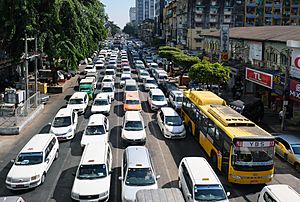
Yangon has a large road network. Many roads are not in good condition or wide enough for all the cars. Most people in Yangon cannot afford a car. They use the city's many buses to get around. Over 300 bus lines operate about 6,300 buses. They carry over 4.4 million passengers daily. Most buses and taxis in Yangon use compressed natural gas (CNG). This helps save money on imported fuel.
Cars are very expensive in Yangon. The government only allows a few thousand cars to be imported each year. This makes car prices among the highest in the world. Despite the cost, more cars are being used, causing traffic jams. In 2011, Yangon had about 300,000 registered vehicles.
It is against the law to drive trishaws, bicycles, and motorcycles within Yangon city limits. Since 2010, certain bus lines have been banned from central Yangon. In 2004, a ban on using car horns was put in place across the city to reduce noise.
In 2017, the Yangon Bus Service (YBS) was created to improve public transport. It aims to be disabled-friendly and uses a card payment system. Ride-hailing services like Uber and Grab are also available.
River Travel
Yangon has four main passenger jetties (docks). They serve local ferries across the river to Dala and Thanlyin. They also connect to the Irrawaddy delta. The Twante Canal was once the fastest way to the Irrawaddy delta. Now, roads are often used. Passenger ferries to the delta are still common. In 2017, a new Yangon Water Bus was launched.
Yangon's People and Culture
Yangon is the most populated city in Myanmar. In 2014, it had 5.16 million people. The city's population grew a lot after 1948. Many people from other parts of Myanmar moved to new towns around Yangon.
Yangon is the most diverse city in the country. While people from India were once the majority, today most people are of Bamar (Burman) descent. There are still large communities of Indians and Chinese Burmese. Many Rakhine and Karen also live in the city.
Burmese is the main language. English is often spoken by educated people. More recently, some people are learning Mandarin Chinese, Japanese, and French for job opportunities.
Religions in Yangon
The main religions in Yangon are Buddhism, Christianity, Islam, and Hinduism. The Shwedagon Pagoda is a very important religious site in the city.
Media and Communication
Yangon is the center for movies, music, advertising, newspapers, and books in Myanmar. All media is closely watched by the government. Television is not allowed for private companies. All media content must be approved by a government censor board.
Most TV channels are broadcast from Yangon. MRTV and Myawaddy TV are the main channels. Yangon also has three radio stations.
Access to foreign media is difficult. Satellite TV is very expensive. Internet access in Yangon is often slow and controlled by the government.
Common services like mobile phones and internet are expensive and limited for many people in Yangon. In 2008, a mobile phone cost about K1.1 million (around US$600). In 2010, most internet users in Myanmar were from Yangon and Mandalay.
Daily Life in Yangon
Property in Yangon is very expensive. Most people rent homes outside the city center.
Yangon hosts many pagoda festivals (paya pwe) during the dry season (November–March). The most famous is the Shwedagon Pagoda Festival in March. It attracts thousands of visitors.
Yangon's museums are mostly for tourists. Most of Yangon's larger hotels offer nightlife and entertainment. This is usually for tourists and wealthy locals. Some hotels have traditional Burmese shows. There are also karaoke bars and restaurants in Yangon's Chinatown.
Sports in Yangon
Yangon has the best sports facilities in Myanmar. Most national sports events are held here. These include track and field, football, volleyball, tennis, and swimming. The Aung San Stadium and Thuwunna Stadium are the main venues for football tournaments.
Most people in Yangon prefer watching European football on TV. Teams like Manchester United and Liverpool are very popular. The Myanmar National League, the country's first professional football league, has a team called Yangon United FC.
Yangon also hosts the annual Myanmar Open golf and tennis tournaments. The city hosted the South East Asian Games in 1961 and 1969.
Yangon has a growing number of skateboarders. A concrete skatepark was built at Thakin Mya park in 2015. It is free for everyone to use.
Yangon's Economy
Yangon is Myanmar's main center for trade, industry, real estate, media, entertainment, and tourism. The city makes up about one-fifth of the country's total economy. In 2010–2011, Yangon Region's economy was worth 8.93 trillion kyats.
Bayinnaung Market is the largest wholesale market in Myanmar for rice and other farm goods. Most of the country's imports and exports go through Thilawa Port, the largest port in Myanmar. There are also many street markets in downtown Yangon. In 2011, street vendors were told they could only sell in their home townships. Since 2009, plastic bags have been banned by city authorities.
Manufacturing provides many jobs. There are at least 14 industrial zones around Yangon. They employ over 150,000 workers in 4,300 factories. Yangon is the center of Myanmar's clothing industry. Most factory workers are young women who come from the countryside. Factories often face problems like power shortages.
Construction is another big source of jobs. However, the construction industry has been affected by the government moving to Naypyidaw. It has also been impacted by new building rules and a slow business environment.
Tourism brings in a lot of foreign money for the city. Before 2007, about 250,000 foreign visitors came to Yangon each year. The number dropped after some political events and Cyclone Nargis. But it has been increasing again. Yangon's hotels need to expand to handle more visitors. A new hotel zone is planned outside the city.
Learning in Yangon: Education
Yangon has many qualified teachers. However, the government spends very little on education. There are big differences in education between rich and poor schools. Schools often rely on "donations" from parents. This forces many poor students to drop out.
While many students in poor areas do not finish high school, a few high schools in richer areas send most students to the best universities. Wealthy families often send their children to private English schools or abroad for university. In 2014, international schools in Yangon cost at least US$8,000 a year.
There are over 20 universities and colleges in Yangon. Yangon University is the most famous. It is now mostly for graduate studies. After the 1988 uprising, the government closed universities many times. They moved most undergraduate students to new universities in the suburbs. Still, many of Myanmar's best universities are in Yangon. Students from all over the country come to study here. The University of Medicine 1, Yangon Technological University, and University of Computer Studies are among the most selective.
Schools for foreign families include:
- International School of Myanmar
- International School Yangon
- Myanmar International School
- Yangon International School
- Lycée français international de Rangoun - Joseph-Kessel
- Yangon Japanese School
Famous Places to See in Yangon
Pagodas and Temples
- Shwedagon Pagoda
- Sule Pagoda
- Botataung Pagoda
- Chaukhtatgyi Buddha Temple
- Kyauktawgyi Buddha Temple
- Kaba Aye Pagoda
- Kyaikkhauk Pagoda
- Maha Wizaya Pagoda
- Ye Le Pagoda
- Shwe Pone Pwint Pagoda
Parks and Fun Places
- Allied War Memorial
- Bogyoke Market (Scott's Market)
- Hlawga National Park
- Inya Lake (formerly Lake Victoria)
- Kandawgyi Lake (formerly Royal Lake)
- Kandawmin Garden Mausolea
- Maha Bandula Park
- Martyrs' Mausoleum
- People's Square and Park
- St Mary's Cathedral
- Sain Lan So Pyae Garden
- Yangon University
- Yangon Zoological Gardens (Yangon Zoo)
Museums and Art Galleries
- National Museum of Myanmar
- Myanmar Gems Museum
- Bogyoke Aung San Museum
- Yangon Planetarium
- Yangon City Hall
Concert Halls and Theatres
- Yangon National Theatre
- Myanmar Convention Centre
Famous People from Yangon
- Further information:
- Nick Drake, English singer-songwriter
- Annabella Lwin, lead singer of English new wave music band Bow Wow Wow
- Honey Nway Oo, important activist in Myanmar
- Giorgi Pirtskhalava (born 1965), retired Georgian football player
- Zainulabedin Gulamhusain Rangoonwala (1913–1994), Indian banker
- Sein Tun (1939–2011), physicist, professor, and author
- Vijay Rupani (born 1956), Former Chief Minister, Gujarat, India
- Zaw Lin Htut, doctor and politician
Yangon's Global Connections
Yangon is a member of the Asian Network of Major Cities 21.
Sister Cities
Yangon has special partnerships with these cities:
 Busan, South Korea
Busan, South Korea Fukuoka, Japan (2016)
Fukuoka, Japan (2016) Haikou, China
Haikou, China Ho Chi Minh City, Vietnam (2012)
Ho Chi Minh City, Vietnam (2012) Kathmandu, Nepal
Kathmandu, Nepal Kunming, China (2008)
Kunming, China (2008) Nanning, China (2009)
Nanning, China (2009) Quezon City, Philippines (2017)
Quezon City, Philippines (2017) Yangzhou, China (1997)
Yangzhou, China (1997)
See also
 In Spanish: Rangún para niños
In Spanish: Rangún para niños


